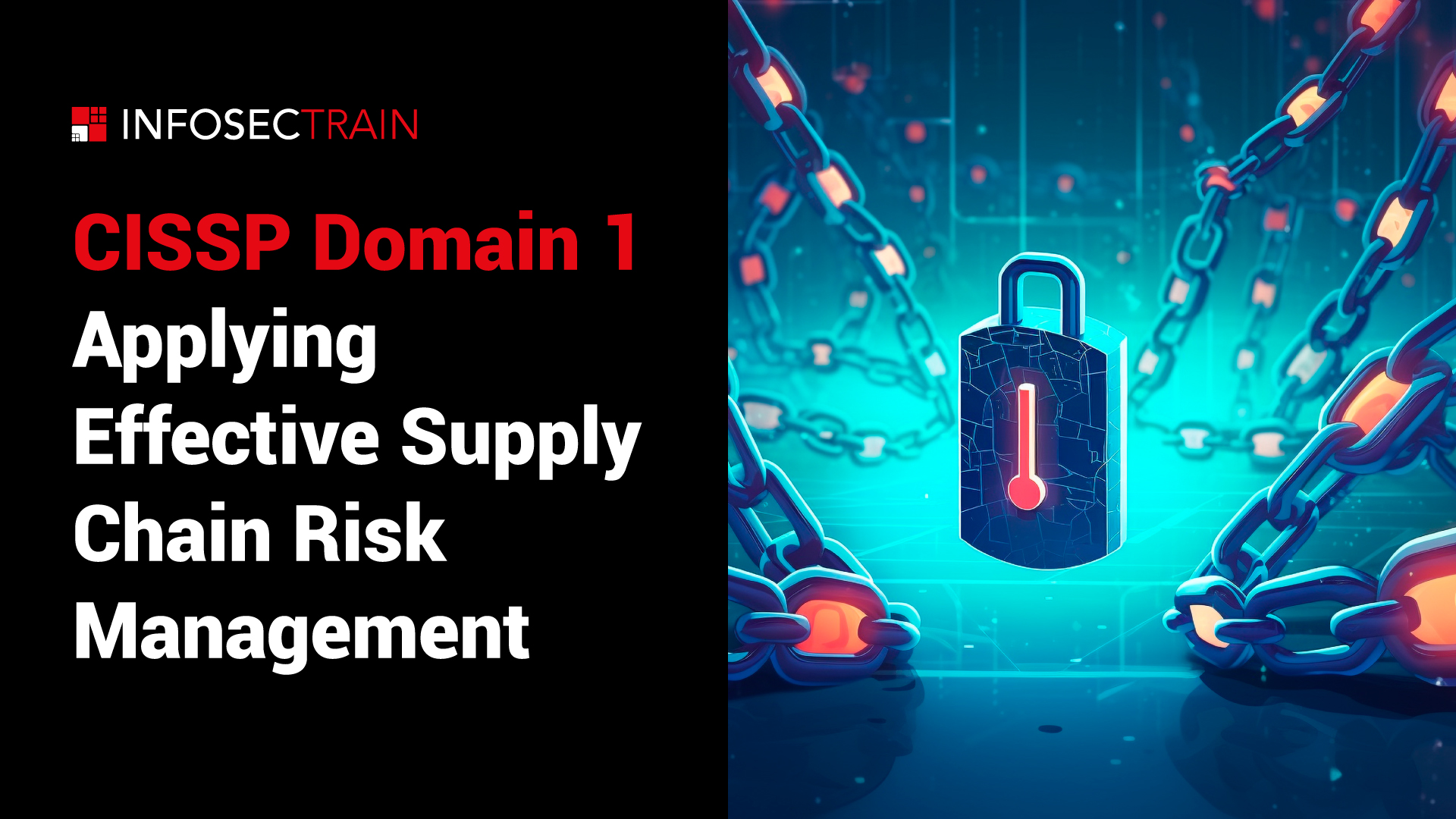CISSP 2024 Domain 1: Applying Effective Supply Chain Risk Management

Understanding Supply Chain Risk Management (SCRM)
Supply Chain Risk Management (SCRM) involves identifying, assessing, and mitigating risks resulting in reliance on external vendors and service providers. The goal is to ensure that all components within the supply chain adhere to the organization’s security policies and do not introduce vulnerabilities. This blog explores a number of important topics, including software bill of materials, silicon root of trust, minimum security standards, third-party assessment and monitoring, and physically unclonable functions. Determining a service-level requirement (SLR) could be required if a supply chain component provider is creating software or offering a service, such as a cloud provider. An SLR is often provided by the customer/client before establishing the SLA, which should incorporate the elements of the SLR if the vendor expects the customer to sign the agreement. This ensures that the security expectations are clearly defined and agreed upon from the outset.
Security Mechanism Integration in SCRM
Supply Chain Risk Management (SCRM) may necessitate the integration of numerous security mechanisms, including silicon root of trust, physically unclonable functions (PUFs), and a software bill of materials (SBOM). By ensuring the security of each link in the supply chain, these measures offer an adequate defense against potential attacks.
Organizations may improve their overall security posture and ensure that all supply chain components are authenticated, verified, and compliant with rigorous security standards by utilizing these cutting-edge security solutions. This comprehensive approach to SCRM is essential for safeguarding vital assets and maintaining trust in the digital ecosystem.
Third-Party Assessment and Monitoring
If third-party services are managed improperly, there can be severe risks involved. Third-party assessment and monitoring entails assessing these external parties to make sure they meet the mandatory security standards. This process typically includes:
- On-Site Assessments: This involves going to the third party’s location to look over operations and interview the staff.
- Document Exchange and Review: This involves analyzing the policies, practices, and incident reports of the third party to make sure security standards are being followed.
- Third-Party Audits: This involves hiring independent auditors to investigate and verify the third party’s security posture in accordance with recognized standards, such as SOC reports.
Minimum Security Requirements
It is crucial to establish fundamental security standards for everyone involved in the supply chain. The security requirements anticipated in the final product should always be met or surpassed by new hardware, software, or services. This commonly involves:
- Specifying Security Requirements: Based on the existing security policies in the organization.
- Contractual Obligations: Ensuring that contracts with third parties include clauses that mandate compliance with these security criteria.
- Service-Level Agreements (SLAs): Formalizing an appropriate security posture by including security expectations in SLAs.
Service Level Requirements (SLRs)
SLRs are comprehensive client-provided specifications that define exactly the expected level of security and service performance. They are often integrated into SLAs to ensure that the vendor meets the security needs of the organization. SLRs include:
- Performance Metrics: Defining acceptable levels of performance.
- Security Metrics: Specifying security measures that the vendor must implement.
- Compliance Requirements: Ensuring the vendor adheres to legal and regulatory obligations.
Strategies to reduce risks associated with third-party hardware
Silicon Root of Trust (RoT)
A hardware-based security base known as the “silicon root of trust” ensures the authenticity and integrity of a system’s boot process. Important traits consist of:
- Tamper Resistance: Implementing safeguards to prevent both software- and hardware-related tampering.
- Secure Boot: Ensuring the integrity of the operating system, bootloader, and firmware at startup.
- Cryptographic Operations: Using the built-in cryptographic features to ensure secure communications and data security.
- Remote Attestation: Allowing remote entities to verify the reliability of the system that is crucial for cloud and IoT devices.
Physically Unclonable Function (PUF)
PUFs give a distinct digital identity that is derived from the hardware’s inherent physical characteristics. The key objective of physically unclonable functions is to offer a very secure, distinct, and impenetrable way to identify devices and store keys. They improve hardware security in the following ways:
- Generating Unique Identifiers: Each PUF generates a unique, unpredictable identifier.
- Device Authentication: Verifying that the hardware components are authentic.
- Secure Key Storage: Safeguarding cryptographic keys within the hardware.
Software Bill of Materials (SBOM)
An SBOM is a comprehensive inventory of all software components employed in a system. It lists all software components used in an application, including their versions, sources, and dependencies. Ensuring software security, compliance, and vulnerability management requires proficient SBOM management. It enhances security by:
- Increasing Transparency: Providing comprehensive information about software components, including versions and sources.
- Vulnerability Management: Enabling organizations to identify and address vulnerabilities in third-party software.
- Compliance Tracking: Making sure that every program element complies with legal and security requirements.
Organizations can improve their overall security posture by utilizing automated tools, including SBOM procedures into the DevOps pipeline, and upholding visibility and transparency. Comprehending SBOM management is essential for CISSP candidates in the Software Development Security sector since it ensures that every software system component is secure, compliant, and up-to-date.
TRAINING CALENDAR of Upcoming Batches For CISSP
| Start Date | End Date | Start - End Time | Batch Type | Training Mode | Batch Status | |
|---|---|---|---|---|---|---|
| 17-Aug-2025 | 27-Sep-2025 | 19:00 - 23:00 IST | Weekend | Online | [ Open ] | |
| 23-Aug-2025 | 28-Sep-2025 | 09:00 - 13:00 IST | Weekend | Online | [ Open ] | |
| 06-Sep-2025 | 12-Oct-2025 | 09:00 - 13:00 IST | Weekend | Online | [ Close ] | |
| 08-Sep-2025 | 13-Oct-2025 | 08:00 - 10:00 IST | Weekday | Online | [ Open ] | |
| 29-Sep-2025 | 04-Oct-2025 | 09:00 - 17:00 IST | Weekend-Weekday | Classroom Bengaluru | [ Open ] | |
| 06-Oct-2025 | 27-Oct-2025 | 07:00 - 12:00 IST | Weekday | Online | [ Close ] |

 1800-843-7890 (India)
1800-843-7890 (India)